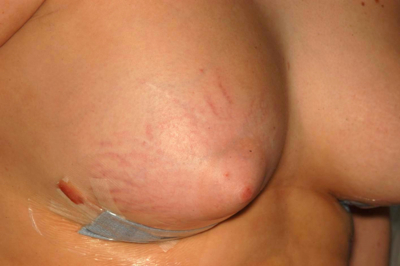A Case Of Striae Distensae Associated With Tissue Expander Inflation
C Lau, R Waters
Keywords
breast asymmetry, striae distensae, tissue expander
Citation
C Lau, R Waters. A Case Of Striae Distensae Associated With Tissue Expander Inflation. The Internet Journal of Plastic Surgery. 2006 Volume 3 Number 1.
Abstract
We present a case of striae distensae associated with tissue expander inserted in a 17 year old patient with developmental breast asymmetry.
Case History
A 17 year old female with asymmetrical breast development was referred for surgical correction. Both breasts were symmetrical in the early stages of development however from the age of 15 the discrepancy had become increasingly obvious. She had no past medical or family history of note and was a non-smoker with a BMI (Body Mass Index) of 24. For the previous two years she had been wearing a size 34 C bra which was too large for her right breast but excessively tight on the left.
On examination, her left breast was significantly larger with a sterno-areolar distance of 23 cm versus 19 cm on the right (Figure 1). After discussion with the patient two options were suggested, firstly a right tissue expander with a subsequent unilateral implant or a second stage bilateral breast augmentation. A joint decision was reached, that the latter option was preferable as it was felt that this would afford closer symmetry.
Four months later she was admitted and underwent insertion of a Mentor contour profile 275cc tissue expander into a submammary pocket as a daycase procedure. A total of 50 mls normal saline was inserted immediately post insertion.
After an initial healing period of four weeks, serial filling of the tissue expander was performed on a weekly basis. A total of 425ml of normal saline was inserted during the course of fourteen weeks (Table 1). At the time of second stage breast reconstruction, significant new onset peri-areolar striae were noted on the right breast (Figure 2). It was reported by the patient that the striae had only developed after the final insertion of 100 ml saline five weeks previously.
Figure 3
The breast augmentation was completed without any complications and a good cosmetic result was achieved. During her most recent review, eight weeks post operatively; the striae had evolved into white atrophic lesions that were barely noticeable.
Discussion
The use of tissue expander has been a widely accepted option for reconstruction in plastic surgery. It allows surgeons to cover defects using local skin of appropriate colour, texture and adnexal structures1. Additional advantages include the avoidance of distant flaps and creation of secondary defects.
A tissue expander consists of a silicone envelope with a self-sealing injection port. In order to achieve the desired result, patients are required to attend clinic on a weekly basis where the expanders are inflated with saline via their injection ports. This and patient discomfort represent the most important disadvantages. As the volume inside the expander increases, tension placed on the overlying and adjacent tissues increases. The amount inflated on each occasion is limited by patients' discomfort, although there is no inflation limit to the expanders themselves according to the manufacturers.
The expanded skin undergoes some well documented changes: the epidermis shows evidence of increased mitotic activity with recruitment of adjacent tissue, this is believed to contribute to the additional skin. The dermis on the other hand undergoes considerable thinning which is often masked clinically by the formation of the thick fibrous capsule that forms around the implant2.
Many complications associated with tissue expanders have been reported. These include exposures of the implant, infections, port failures, expander ruptures and perforations. A complication rate of 22% has been reported with 87% of which belonging to the major complications category such as those mentioned above3.
Striae distensae (SD) are a common disfiguring cutaneous condition characterised by linear smooth bands of atrophic appearing skin which occurs in areas of dermal damage produced by stretching4. The exact aetiology of SD remains controversial and this is partly due to the wide variety of clinical situations in which they arise. A strong genetic predisposition has been implicated as this condition has been reported in monzygotic twins5. This is further suggested by the decreased expression of collagen and fibronectin genes in affected tissue6.
The aetiology of the striae in this case is not known. However, the patient's increased susceptibility to striae formation is demonstrated by her history of thigh striae and family history of striae gravidarum7. Secondly, it is possible that inflation of the tissue expander was too rapid leading to excessive skin tension. The regime for expansion followed our usual protocol and there was no apparent excess of tension at any time. Although a case of striae distensae of bilateral augmented breasts following oral contraceptive therapy has been reported8, this is unlikely to be a contributing factor as our patient denies any history of regular medication. To the authors' best knowledge, the complication of striae formation associated with tissue expander inflation has not been previously documented and has certainly not previously been seen in our own practice.
Correspondence to
Miss. Ruth Waters, FRCS(Plast), Consultant Plastic and Reconstructive Surgeon Department of Plastic and Reconstructive Surgery University Hospital Birmingham NHS Trust, Selly Oak Hospital, Raddlebarn Road, Selly Oak, Birmingham B29 6JD Phone: (44) 121 627 8905 Fax: (44) 121 627 8461 Email: ruth.waters@uhb.nhs.uk


